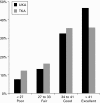Unicompartmental knee arthroplasty: is the glass half full or half empty?
- PMID: 26430080
- PMCID: PMC4632649
- DOI: 10.1302/0301-620X.97B10.36542
Unicompartmental knee arthroplasty: is the glass half full or half empty?
Erratum in
-
Errata/Corrigenda.Bone Joint J. 2015 Dec;97-B(12):1732. doi: 10.1302/0301-620X.97B7.37439e. Bone Joint J. 2015. PMID: 26637692 Free PMC article.
Abstract
There is a large amount of evidence available about the relative merits of unicompartmental and total knee arthroplasty (UKA and TKA). Based on the same evidence, different people draw different conclusions and as a result, there is great variability in the usage of UKA. The revision rate of UKA is much higher than TKA and so some surgeons conclude that UKA should not be performed. Other surgeons believe that the main reason for the high revision rate is that UKA is easy to revise and, therefore, the threshold for revision is low. They also believe that UKA has many advantages over TKA such as a faster recovery, lower morbidity and mortality and better function. They therefore conclude that UKA should be undertaken whenever appropriate. The solution to this argument is to minimise the revision rate of UKA, thereby addressing the main disadvantage of UKA. The evidence suggests that this will be achieved if surgeons use UKA for at least 20% of their knee arthroplasties and use implants that are appropriate for these broad indications.
Keywords: unicompartmental knee replacement; unicompartmental knee arthroplasty.
©2015 Murray.
Figures







References
-
- Kurtz S, Ong K, Lau E, Mowat F, Halpern M. Projections of primary and revision hip and knee arthroplasty in the United States from 2005 to 2030. J Bone Joint Surg [Am] 2007;89-B:780–785. - PubMed
-
- No authors listed. 11th Annual Report of the National Joint Registry for England, Wales and Northern Ireland. National Joint Registry. (date last accessed 20 July 2015).
-
- Liddle AD, Judge A, Pandit H, Murray DW. Adverse outcomes after total and unicompartmental knee replacement in 101,330 matched patients: a study of data from the National Joint Registry for England and Wales. Lancet 2014;384:1437–1445. - PubMed
-
- Willis-Owen CA, Brust K, Alsop H, Miraldo M, Cobb JP. Unicondylar knee arthroplasty in the UK National Health Service: an analysis of candidacy, outcome and cost efficacy. Knee 2009;16:473–478. - PubMed

